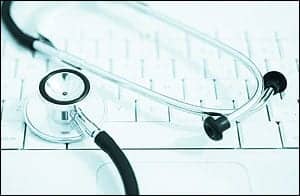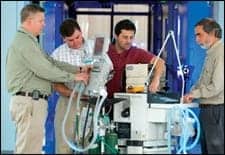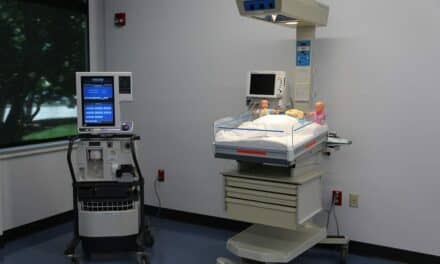Contrary to popular belief, electronic medical records (EMRs) and electronic health records (EHRs) are not interchangeable terms referring to the same concept. Rather, they represent different systems with different aims. EMRs are owned by the health care institution and are the legal record of the patient’s experience. EHRs contain data from EMRs but are owned by patients (or a stakeholder, such as an insurance company), and are meant to follow patients even when they change providers.
EHRs are contingent upon the formation of a national health network, which has not yet been launched. EMRs rely on connections to individual devices or interface engines within a health care organization. The EMR is the source of data for the EHR, but the EMR ultimately requires an EHR to maximize its potential. So the two are synergistic, if not interchangeable.
However, for the biomed, the difference is negligible. “As far as the biomed’s role, I see very little difference in EMR versus EHR,” says Derrick W. VanKampen, CompTIA Network+, CompTIA RFID+, CWNA (certified wireless network administrator), a biomedical device integration analyst 2 in the information technology (IT) department of Tampa General Hospital in Tampa, Fla. “Either way, you’re trying to get HL7 output to both of them.”

EMRs rely on connections to individual devices or interface engines within a health care organization and are the source of data for the EHR.
With the Health Information Technology for Economic and Clinical Health Act enacted as part of the American Recovery and Reinvestment Act of 2009, the pace of EMR implementation within individual institutions and practices has picked up and can be expected to get faster as the 2012 deadline for incentive compliance, otherwise known as meaningful use, gets closer. Those who have not yet started implementing an EMR may already be behind.
“There are a lot of items that facilities and clinical engineering will have to look at, assess, and complete in a very short amount of time, which means there are a lot of organizations that are going to have a lot of work coming their way very fast,” VanKampen says.
Beginning to End
That work will include research, preparation, collaboration, and lots of testing. Meaningful use requirements necessitate certain capabilities, such as computerized physician ordering, many of which require smooth integration.
Assessment typically starts long before any physical work is done. The clinical engineering team must determine which devices are priorities for integration, which devices are capable of integration, and which devices need to be upgraded or replaced to be able to integrate.
The evaluation cannot be made in a vacuum but rather must be completed through collaboration among various departments. In addition, it should be considered in conjunction with the type of installation that will occur. Options today include direct integration into the EMR or use of an interface engine to translate data into a format usable by the EMR.
Once these decisions are made, the physical work can begin. In some facilities, clinical engineering will take part in the actual installation of the EMR onto the network, often in concert with the vendor and the IT department.
“In our hospital, we do a lot of the ‘dirty work,’ as people say,” says Ilir Kullolli, MS, clinical engineer lead for the perioperative information management system at Brigham and Women’s Hospital in Boston. “We plan our network, build our own network closets, and program our own switches because, at some point, we’ll have to troubleshoot it, and the best way to troubleshoot [a system] is if you know it.”
Testing, Testing, Testing
Biomeds, therefore, can and should participate in the entire process, from the decision to implement to ongoing service and maintenance. The assessment process typically starts a year or so before an EMR system is implemented. Once the necessary decisions have been made, installation and implementation can take anywhere from 3 to 9 months, according to Jon Kimerle, vice president of clinical transformation for SSM Integrated Health Technologies (SSMIHT), headquartered in St Louis.
The length depends in part on the number of devices that will be integrated. “It really varies with each facility because we might have anywhere from 200 devices to 400 devices,” says Debbie Stagner, RN, product specialist in clinical documentation with SSMIHT. Many institutions, particularly larger ones, implement in phases—for instance, fixed instruments first or all operating rooms first.
Each device selected is typically mapped and tested to be sure data is transmitted accurately, maintaining its integrity and assuring its correct placement within the EMR. This involves naming schemes and correct associations.
At Brigham and Women’s, the system selected does not have the ability to use the patient ID for mapping. “We associate the data with the room and the time, so we have to make sure a device in a room is mapped correctly. Otherwise, we could be getting data from room 21 instead of room 20,” Kullolli says.
Naturally, the wrong data can negatively impact decision support, so rigorous testing is required. “You’re going to have to test every single piece of equipment before it goes onto the EMR to verify that it is outputting data and that it’s outputting the correct data,” VanKampen says. If middleware is a component, testing will verify the data integrity as it arrives and leaves the interface device and the EMR.
To be sure everything is working as intended, biomed teams often switch up connections to make sure the mapping is still correct. “We build them, test them, move them to another production, and test them again,” Stagner says.
Most testing occurs before the EMR goes live, but it may also be done post-launch. “When you’re doing a pilot, they’re doing record keeping on paper and on the computer, so there’s really no risk for the patient, but we’re still doing some post-live testing because when you go live, sometimes you see things you couldn’t in testing mode,” Kullolli says.
Brigham and Women’s has been completing these evaluations for about a year, with more rigorous testing performed in the past 6 months. Kullolli estimates about 80% of the biomeds’ time has been spent on this task.
Never Too Early
Time and workload, however, are not the only challenges. Proper preparation is key to successful implementation and can never be started too soon. Kimerle credits the foresight of SSM’s clinical engineering services team for minimizing issues with compatibility. “CES has been thinking about this for years out, starting about 3-plus years ago, when they made sure that new monitors had some interface capabilities around HL7,” Kimerle says.
Additionally, the team also considered virus protection, one of the bigger challenges encountered with implementation at the DePaul Health Center. “A lot of equipment doesn’t support anti-virus programs, and when you hook it on to the network for the first time, it becomes susceptible to viruses,” says Mike Vohsen, operations manager for clinical engineering with SSMIHT at the DePaul Health Center, an SSMIHT facility in Bridgeton, Mo. The solution was to work with manufacturers to install software patches where possible. They also looked into firewalls and, in some cases, settled on manual cleanup.
At Tampa General, outfitting and testing existing operational departments has been a big challenge and is one shared by many organizations with tight inventories. “There have to be strategies developed to get access to equipment and rooms that are being used every single day,” VanKampen says.
In some instances, the biomed can complete the work with the patient in the room. In cases where this is not possible, the team has to coordinate with the nurse manager to isolate a room. “I think a lot of it is the logistical work—the communication with the nurse managers and administration,” VanKampen adds.
Team Effort
Collaboration is another key to successful EMR implementation. Because the system is used throughout the enterprise, the implementation effort needs to be multidisciplinary. Biomeds must work not only with nurses and clinicians, but also with IT. “We work quite a bit with the information service group inside the hospital and with the members of the integration team,” Vohsen says.
For some facilities, this cooperation is new; in others, particularly those that have been integrating devices with information management systems for some time, shared projects are old hat.
“Traditionally, IT and biomed have been separate entities,” VanKampen says. “Here at Tampa General, our biomedical engineering department is outstanding at what they do, and our IT department is outstanding at what they do. The EMR gives us a chance to be outstanding at working together.”
This requires openness and willingness on both sides to not only work together, but also to communicate and learn concepts applicable to both fields. Unfortunately, such a change in culture can be difficult to instill. There are technicians who are resistant to taking on more responsibility and acquiring new knowledge. “With new hires, we make it clear they will have to do some work on the EMR,” Kullolli says.
The increasing need for collaboration between biomed and IT is creating change in the career fields that is beginning to filter down into the workforce. SSM created its integrated health services division to facilitate cooperation among its IT and biomed divisions by bringing them both into one hierarchy structure. “By having it all under one umbrella, you can make sure things don’t fall through the cracks and communication works out better,” Vohsen says.
In facilities where departmental restructuring is not an option, other solutions may work. At Tampa General, two new positions, titled biomedical device integration (BMDI) analysts, have been added to the staff in both biomed and IT. VanKampen, who, along with the head of the facility’s IT technology and standards department, designed the job descriptions and campaigned for the expansion of staff, was named to one of these positions in the IT department. An IT counterpart holds the same role within the biomed department. The goal of these new roles is to serve as liaisons between the two departments, helping to educate and communicate. “In IT, you’ve got a lot of acronyms and job-speak; and you have other acronyms and job-speak for biomed,” VanKampen says. “So, essentially, if you’ve got two groups speaking in two different languages, you need a translator, and that’s what I was going for.”
Rather than justify the novel approach with an analysis of the return on investment to secure the new positions, VanKampen and his colleague used job descriptions and scope. “We showed the amount of work involved, especially the extensive research and development and testing of equipment,” he says. “From this point on, every piece of equipment that a nurse manager tries to get a requisition for, we have to examine to make sure it’s going to be something that is EMR friendly, has a Wi-Fi card, and meets all the parameters we’re looking for to acquire equipment that is as automated as possible.”
Expanding Responsibilities
To achieve his objectives, VanKampen set about obtaining three IT-related certifications (CompTIA Network+, CompTIA RFID+, and CWNA) on Tampa General’s budget, so that he could become well-versed in the discipline’s language. Kullolli has also completed some training specific to the EMR system. The knowledge is expected to make service and management of the EMR easier.
Generally, these systems are fairly reliable. If problems do arise, they often involve incorrect transmission of data (or no transmission at all). Some systems provide tools to warn users about miscommunications; many other solutions rely on users alerting the service teams. Vohsen expects that as advances in the technology are made, most medical device manufacturers will create software with a feedback loop to verify data transfer and notify users of problems.
Clinical engineering typically takes the first look at a problem, in part because it may have originated within the medical device interface and in part because biomeds are accustomed to rapid response and clinical environments. “We’ve seen that [IT staff] find it very hard to work on-site or in the operating room,” Kullolli notes.
However, IT does step in when the problem falls into their realm, such as an issue with the EMR or network itself. Problems whose solutions elude both departments require outside assistance, typically from the vendor.
Biomeds may also be responsible for software upgrades and revisions, particularly on devices and interface engines, which can sometimes create problems. Without such a change or a specific directive, however, mapping of data transfer should not alter itself, though adding devices or moving them around will require more testing.
“If CES were to add new devices to a unit, we’d want to test one and make sure the communication and messaging is the same,” Stagner says. “Any time we move a unit, we’ll do some double-checking, some rebuild, and definitely testing.”
|
Are you involved in EMR implementation? Blog about it with us. |
In the future, however, biomeds may be required to do more network service and maintenance. “We, as clinical engineers, usually take care of a lot of hardware and single devices, and we’re not really used to a lot of systems being put together,” Kullolli says. “So we have to step up, get out of our comfort zone, and start learning about networks and IT.” Both departments need to work together, along with clinical and administrative units.
“It’s really about the teamwork,” Kimerle says. “EMR is an integrated solution and crosses multiple skill set domains—and you tend to implement a little faster or a little better when you have all the right people in the room working on it.” Similar to the relationship between EMR and EHR, as technologies advance, clinical engineering and IT will find themselves synergistic but not interchangeable.
Renee Diiulio is a contributing writer for 24×7. For more information, contact .
EMR Versus EHR
EMR, which stands for electronic medical record, and EHR, representing electronic health record, have become interchangeable terms to the noninitiated. However, the two monikers actually refer to two distinct entities. The Healthcare Information and Management Systems Society (HIMSS) differentiates the two concepts in the following way:
The EMR or electronic medical record is an application environment composed of the clinical data repository, clinical decision support, controlled medical vocabulary, computerized provider order entry, pharmacy, and clinical documentation applications. It is supported across inpatient and outpatient environments and is used by health care practitioners to document, monitor, and manage health care delivery within a care delivery organization (CDO). The data in the EMR is the legal record of the patient’s encounter at the CDO and is owned by the CDO.
The EHR or electronic health record is a subset of each CDO’s EMR, presently assumed to be summaries like ASTM’s continuity of care record or HL7’s continuity of care document. The EHR is owned by the patient and enables patient input and access that spans episodes of care across multiple CDOs within a community, region, or state, and, in some countries, the entire country. The EHR in the United States is expected to be accessible through the proposed National Health Information Network.
—RD
Source: Garets D, Davis M. Electronic medical records vs electronic health records: Yes, there is a difference. A HIMSS analytics white paper. Healthcare Information and Management Systems Society (HIMSS). January 2006. Available at: www.himssanalytics.org/docs/wp_emr_ehr.pdf. Accessed May 4, 2010.





